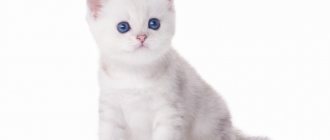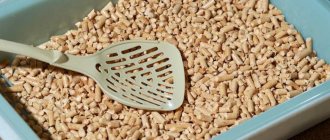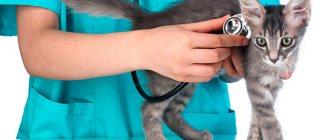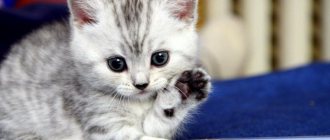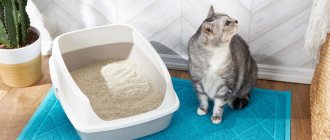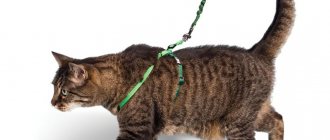Modern cat owners are faced with the problem of what to feed their pet – ready-made diets or homemade food? In this case, it is enough to weigh all the pros and cons and choose the appropriate option. But what to do if a pet gets into the house and is accustomed to dry food, while the owner is determined to treat the new family member with regular food? Or does a situation arise when dry food is banned for one reason or another? In any case, you should approach the issue of feeding a purring pet with all seriousness and transfer it to new food gradually, avoiding possible negative consequences.
Irreparable harm to health from dry food
Such food can cause a lot of problems, the most common of which include:
- vitamin deficiency – many dry foods do not contain sufficient quantities of certain vitamins that are so necessary for the pet and which are found in homemade food;
- dysbacteriosis – beneficial bacteria die in the stomach, and a disorder occurs;
- poisoning – your pet can be poisoned by various dyes that the food contains;
- heart and kidney diseases - since this food contains a lot of salt, the kidneys may be the first to suffer from it, because it is difficult for them to excrete them. Poor kidney function will, in turn, provoke heart failure;
- allergies – ulcers may appear in the animal’s mouth or hair may begin to fall out;
- cancer - most types of food contain monosodium glutamate, which is known to cause tumors.
To avoid this kind of trouble, you need to teach your cat to eat regular food.
© shutterstock
Common mistakes when changing feeding methods
Common mistakes that cat owners make when changing the way they feed them:
- Abrupt transfer from one food to another. There is no need to rush in this situation. A smooth transition from the usual to a new type of food will allow your pet to avoid problems with digestion and stool. Ideally, this process should take about 1.5 weeks.
- Concession to blackmail from a four-legged pet. Almost all animals protest against changes in diet, refusing to eat and begging for their favorite food.
- Long-term ignoring of a cat's hunger strike. It is important not to miss the moment when fasting will harm the four-legged blackmailer.
- Application of physical methods. When forcing your pet to eat natural foods, you cannot shout at him or hit the animal. This will cause him severe emotional distress.
- Leaving self-prepared food in a cat's bowl for a long time. If within half an hour the cat has not touched the contents of the bowl, it is recommended to throw it away, otherwise it will spoil and the pet will be poisoned.
Features of the daily diet of cats
However, for an animal to grow healthy, feeding it just normal homemade food will not be enough. Nutrition must be balanced . It is necessary that your pet’s diet include the following foods:
- Meat – it is better to give it to the animal raw. It shouldn't be greasy. It is best to buy beef, turkey or chicken.
- Fish. It needs to be boiled and given to your pet about 2-3 times a week. It also shouldn't be greasy.
- Yolk. About once a week, Murka should eat 1 piece.
- Liver. It is given boiled.
- A variety of regular dairy products.
- Soups and broths.
- Various porridges.
- Vegetables. This issue requires an individual approach, since each animal has its own taste preferences. For example, some people like potatoes or cucumbers, while others like melon or watermelon. In any case, this is wonderful and if your pet asks for vegetables, be sure to pamper him with them.
Show the iron character of the owner of the house
Weaning your pet off dry food is not an easy task, but in this matter there is no need to succumb to provocations and make concessions to your pet, refusing to introduce homemade food into the diet.
While accustoming your cat to homemade food, you may encounter the animal being stubborn. But you will also show your iron character. If you provide your animal with homemade food and it doesn’t even touch it within 20 minutes, hide the bowl. And try to feed him already at lunchtime.
If the cat doesn’t eat, it means it’s not hungry. Don't beg her on your knees for her to eat homemade food.
Don't worry if your cat's feedings are unsuccessful and she hasn't eaten for about three days. Of course, starvation of an animal that lasts more than a day already poses a danger to the body. The cat may even lose weight and look completely weak, but do not be afraid, having homemade food in front of her eyes, she will not choose to die from hunger, no matter how tasty the food may seem to her.
Don’t forget, the cat’s health depends on what he eats at home. It is better to show the steadfastness of your character and not resort to various tricks of a cunning pet than to sentence it to inevitable and terrible health problems.
Many cat owners have encountered the fact that a kitten purchased from a breeder or in a nursery refuses to eat any other food other than ready-made store food. This behavior may be due to the fact that the kitten’s old owners fed it only with these foods, and he went to them. I'm used to it.
It is necessary to wean a kitten off such food not just because it is expensive to buy food for it, but also because it can harm its health. Almost all veterinarians claim that cats not only do not get all the necessary vitamins from prepared food (no matter whether dry or wet), but it is also harmful to them.
How can you train a cat to eat homemade food? There are several ways - the most popular and effective method is to gradually replace the food with another food. To do this, on the first day you need to replace ten percent of the usual amount of food with regular food - if the kitten prefers wet food, you can add various cereals to it, and if he usually eats dry food, then it will be best if you prepare a special porridge for the kitten - it is done quite simply - you need to boil the sausage trimmings (or you can boil some plain meat), and just add cereals to it. Over time, every day or every other day, reduce the amount of food in the bowl, and over time, leave only homemade food - the kitten will already get used to it and will eat it with pleasure.
There is also a faster way - immediately put other food in his bowl instead of food - sooner or later the kitten will get hungry, and still eat what is given.
Even if the kitten does not eat porridge and soups, it is unlikely that he will refuse a piece of meat or sausage. If he eats this, then next time try putting meat mixed with bread, pasta, or other food in his bowl. Still, it is unlikely that you have the opportunity to feed him only meat. Gradually he will get used to it and will start eating it all without adding sausage.
Another option is to feed the kitten twice a day, preferably always at the same time. In the morning, put meat in his bowl instead of food, it could be beef or chicken, cut into small pieces. You can give your kitten both raw and cooked meat. If the kitten won't eat it, just put it in the refrigerator. During the day he will probably get hungry, and if in the evening you again offer him the same thing that you gave him in the morning, most likely he will still eat it. Surely, if this repeats day after day, and the kitten understands that his favorite food will no longer be given to him, he will start eating homemade food.
This means you made the right choice by deciding to have a kitten in your home. By nature, cats are freedom-loving animals, but they also do not refuse to live in warmth and comfort. When a person got his first cat, history is silent. But many facts are known when cats became the favorites of great rulers. Looking at the behavior of these little fluffy balls, sometimes it even seems that the pinnacle of evolution is the cat, and this is true for people, creatures called upon to feed them, love them and clean up after them.
With the appearance of such a newcomer in the house, inexperienced cat breeders immediately have many questions. One of them is what to feed a cat? Previously, cats fed themselves by catching mice and other living creatures, and they only came into the house to sleep, get a portion of attention and eat something. But modern cats more often become just a decorative element of the house, a member of the family, but not a hunter and breadwinner.
Cat fast food.
Many owners make a huge mistake by accustoming their cat to inexpensive cat food, mostly dry. This product does not need to be cooked, you just need to pour it into a bowl, and that’s it – lunch is ready. But by choosing this type of cat food, we are more likely to behave selfishly than rationally.
Most likely, this is not the first time you have heard the news that such foods are harmful if consumed regularly, and can also be addictive. And consciously feeding your cat such food is the same as completely switching you from homemade food to semi-finished products, and not of high quality. And while saving time and justifying yourself by saying that your pet likes it, you yourself will not be happy with this choice. But not all food is equally bad. There are foods that are approved for consumption, and even recommended, but it is worth taking into account their rather high cost, and the fact that a cat’s diet cannot consist only of this dry food or canned food. In any case, there should be variety in food.
Proper nutrition.
How to teach a cat to eat properly depends only on your personal relationship with the cat and its taste preferences. Cats are like people; they don’t always want to eat what they are given and can be picky eaters. Or it happens the other way around: a cat happily eats everything that is given to him, but this is the exception rather than the rule. So, if you want to teach your cat to eat properly, put patience and effort into it.
And so, the best for a healthy cat diet are: raw, lean meat (pig, but not pork, beef, horse meat, chicken, turkey), lean boiled fish (no more than 2-3 times a week), boiled yolk ( 1 time per week), boiled liver, raw tripe of ruminants. From your diet, you can give your cat soup or broth, but without excess fat, porridge from cereals such as barley, buckwheat, wheat (but not millet), oatmeal. It is better to give rice only cooked in milk to avoid the possibility of constipation, especially if your cat is predisposed to it.
You can also teach a cat to eat fruits, vegetables, greens; often the animals themselves willingly reveal such a desire, so seize the moment.
There are also foods that are not advisable to give to cats, such as: raw liver, raw fish, especially with small bones, dairy products (only if the cat is personally immune), fried, smoked and fatty foods. Remember that the cat is a raw food animal, so do not exclude raw meat from its diet. As for dairy products, such a ban exists only for the period after weaning. Then your kitten may simply not accept whole milk. Over time, you will be able to give him milk, sour cream and even condensed milk in small quantities. Also, small kittens do not need to be given raw meat in its pure form, and raw fish. Having tried such products, he may then completely refuse other foods.
Study, study and study again.
It is best to teach your cat to eat properly from a very young age. Then the easiest way is to let her try the whole range of products, and then focus on her preferences. Usually small kittens, especially those picked up on the street, are very partial to food and are ready to live near their bowl. But don’t let us awaken in yourself a feeling of pity and doubt that you are not feeding him enough. Cats are curious by nature and always asking for food. So, looking into your plate, or keeping watch near the refrigerator, is considered a matter of principle among them. Feed small portions. From the first days, try not to mix too many products, this will make it easier for you to determine what your cat has a negative reaction to and when she is just being capricious. Also, do not be fooled by the cat when he demonstratively turns away from the offered food. Remember, not a single cat has ever died from hunger if there was food in the plate. It’s often harder with animals than with children, just remember yourself, you didn’t eat everything either. But the main thing for you in this matter should remain healthy interests, and not self-indulgence. Make sure that the food is always fresh and of good quality; a cat, like a person, having eaten one poor-quality product, will not touch it again in its life.
In the article I will describe in detail how to wean a cat off dry food and accustom it to normal natural food. I'll tell you what the difficulties are. I will explain to pet owners what actions to take if the animal eats exclusively dry food and nothing else. I will describe common mistakes owners make when changing the type of diet.
Let's consider popular ways to change the type of food for an animal:
- The transition to natural food must be gradual. Try mixing certain ingredients
into the dry mixture. At the beginning there should be a small amount of them. If the cat accepts your conditions, over time it is recommended to increase the proportion of natural food until you completely give up dry food. It is better to start with finely chopped pieces of boiled beef. It's healthy and tasty; - If your pet has a preference for natural products, you should focus on them. It is recommended to gradually increase the portion
of food of natural origin until you completely replace artificial food; - If the owner does not know the preferences of the pet, you need to try the most common treats of other cats. They are laid out in front of the animal in various bowls
. This way you let your pet know that he has a choice. This should be done until he decides. Then they act, as mentioned earlier, gradually increasing the portion of natural food; - You can try giving your cat food in two different bowls
. Moreover, one will be dry, and the other will be natural. You need to pour a smaller portion into the first container than into the second. The animal, without having eaten, will have to finish eating healthy food. There will be no other way out; - The most radical and harsh way is to simply stop feeding the cat dry food
. Every animal has an instinct of self-preservation, so it will have to agree to your terms. But these are extreme measures; it is better to try other, softer options.
How to force an animal to eat unusual and tasteless food
The main thing is that when you want to accustom your dog to normal food, then make sure that the food is fresh . Having once tasted a stale dish, a pet will remember it for the rest of its life and will never touch such food again. Also make sure that there is always new water in the bowl.
In addition, the cat should eat one type of homemade food at a time; if it is soup, then only soup, if it is meat, then only meat, and so on. This will ensure proper functioning of the gastrointestinal tract and will not cause any health problems for your pet in the future.
Cats need three meals a day, but if the animal does not eat for about two days, then it is necessary to urgently seek help from a specialist.
© shutterstock
If you want to accustom your cat to homemade food, first of all you should:
- be patient;
- develop a step-by-step plan;
- strictly follow all our advice.
It is necessary to gradually accustom the cat to homemade treats. To begin with, you should buy two types of food - dry and canned. With the help of the second, you can gradually accustom your pet to wet food.
3 stages of transition to homemade food:
- You need to mix two types of food. First you need to mix in a very small amount of canned food, gradually increasing the dose.
- Over time, we replace the dose of dry food with meat and porridge.
- You need to reduce the dose of dry food by half in 5 days, and leave only the gravy from canned food.
- The moment you introduce gravy into the diet, it would be wise to give your cat probiotics to support her stomach and normalize her intestinal flora.
- Over time, the amount of gravy is also reduced and comes to the point where you only need to add a couple of drops to the homemade food for flavor.
- After this, the cat should be offered homemade food, which will make up its almost daily diet.
If you finally want to accustom your pet to home-cooked food, then at this stage you need to be prepared for a variety of problems, since the stomach needs time to adjust from dry food.
At what age do kittens start eating on their own?
In the first days of life, babies are breastfed and do not require special human care. Nutrition problems fall on the mother cat.
Little kittens are completely helpless, so the owner should be patient and pay special attention to how and what to feed the baby correctly
After 3 weeks, she will need the help of her owner, because the kittens are already becoming more active and independent, moving around the house, learning to go to the toilet.
From this moment on, the cubs are weaned from their mother's milk.
Important! Until about one month of age, kittens should be fed low-fat milk up to 8 times a day.
Features of feeding kittens at different ages
Pets aged 1-1.5 months are fed liquid food at least 5-6 times a day, the following dishes are suitable:
- Puree (vegetable or meat);
- liquid unsweetened semolina porridge;
- skim cheese;
- boiled yolk.
At 2 months, the animals have their baby teeth and can now be fed solid food. But it is impossible to exclude liquid food, since it is necessary for the proper functioning of the digestive system.
As an animal grows, its need for food and nutrients increases.
At 2 months you can already give the following food:
- lean boiled meat;
- cottage cheese;
- chicken yolk;
- milk;
- yogurt.
Be sure to read:
A kitten meows: reasons, how to quickly calm it down, what to do when you need veterinary help
Food should be rich in vitamins and nutrients. From childhood, teach your pet to eat cereals and vegetables in addition to milk, fish and meat.
Why is it so difficult to transition cats to normal homemade food?
Includes special components:
- attractants;
- additives.
It is they that cause a pet to become addicted to store-bought food and become the biggest obstacle to the transition to natural products.
There is a high concentration of such substances in super-economy class feed.
This applies to kitiket and whiskey, which are especially popular among cat owners.
By purchasing such food for your pet, you are making him a kind of drug addict. The animal becomes dependent. The more he eats such food, the more difficult it will be to wean him off it.
In addition, manufacturers of artificial food for animals, using such components, try to hide the lack of useful natural substances in food.
This food is not just useless for the animal. It can cause the development of various diseases of the digestive system, including mental disorders. Especially if the owner is trying to wean the cat from its usual treat.
